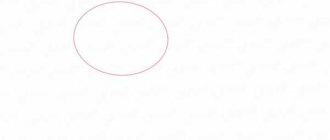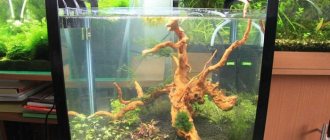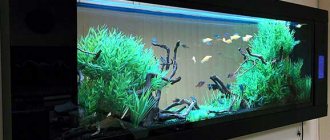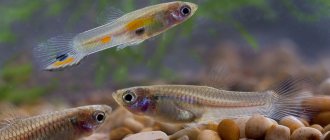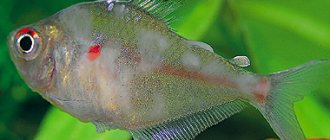Pencils, paper and tools
To create a picture you will need:
- a set of pencils with different leads;
- thick white paper;
- compasses and rulers;
- eraser and sharpener.
You can replace the compass with any round object, and use cards or a sheet of paper instead of rulers.
Rectangular aquarium with fish
An aquarium (drawing for children with a simple pencil) of a rectangular shape is quite easy to draw. The free space inside it can be easily filled with various shells, since the boundaries are clearly defined.
Step by step process
Algorithm for performing the work:
- On a blank sheet of paper, draw a vertical line, which will be the starting point for drawing the aquarium. Based on this point, draw a volumetric cube - a glass container.
- Having retreated a small distance from the top of the aquarium, draw wavy lines (vertical) along the edge of the water.
- Draw a few simple fish inside the aquarium. You can also add goldfish and octopus.
Rectangular aquarium - drawing for children
Rectangular aquarium - drawing for children
- A simple fish is quite easy to draw. Place a dot on a piece of paper. Starting from the point, draw a small arc directed downward. From the same point, draw another arc, vertically symmetrical to the previous one.
- In the area of the tail, connect the edges of the arcs with a straight line.
- Use one arcuate line to separate the head area from the body. Add eyes, show scales and fins.
- A goldfish is much more difficult to draw. On a blank sheet of paper, draw an oval, slightly elongated along a vertical line.
- Visually divide the oval into 2 parts. Having marked the middle (horizontally), move slightly to the left and put a small dot. Draw the head of the fish from the body along the previously marked point.
- Add 2 small semi-ovals on the left side of the picture - as shown in the picture.
Rectangular aquarium - drawing for children
Rectangular aquarium - drawing for children
- Draw 2 arcuate lines (above and below the body). Connect the lines with wavy features, forming the wide fins of the fish.
- At the top of the head, draw an oval eye, elongated horizontally. Add a thin line above the eye, and also outline the pupils and highlights on the eyes.
- From the right side of the body, add 2 arched lines that will form the outline of a wide tail. Connect the lines with each other using wavy, ragged features.
- Using curved lines, show the places of folds and creases on the fins and tail of the fish. Add arcuate lines across the entire surface of the body that will show the scales.
- An octopus is quite easy to draw. First draw an uneven circle. To the bottom of the figure add elements reminiscent of water drops - a narrow beginning and a teardrop-shaped oval. Connect the figures together and draw the face.
Fish drawing step by step
- You can draw algae and stones on the bottom of the aquarium.
- Inside the aquarium itself, add spherical figures - air bubbles.
You can outline the main lines with a felt-tip pen, and duplicate smaller details with a sharp pencil or gel pen.
Making the correct contours.
We connect the body with the tail. We update the fins with smooth, wavy lines, giving them the correct shape.
Using several semicircular lines we separate the gill. Draw a fish eye from two circles. Color the fins with thin lines.
3
Simple drawing
The aquarium (drawing for young children) has an unusual shape. It can easily fit into the decor of any room as it does not take up much space.
Step by step process
How to draw an aquarium:
| Stage | Description | Image |
| 1 | Draw an oblong oval on a blank sheet of paper. It should be slightly elongated along a vertical line. | |
| 2 | Form a neck above the previously drawn figure. To do this, you can draw a small oval, also stretched vertically, but with a smaller diameter. Draw straight edges from the neck, and then connect them to the main shape, drawing a more natural shape of the container. | |
| 3 | Draw the line of the neck from the main container with a slightly curved line. Duplicate all the outlines of the aquarium inside the drawn figures, retreating a small distance. Before reaching the top line, draw zigzag lines on the surface of the water. | |
| 4 | Draw mounds of sand using wide zigzags on the bottom surface of the aquarium. Add small dots to show the texture of the material. Draw algae on both sides and in the middle of the aquarium using high, winding lines. | |
| 5 | You can “place” any fish or additional decor in the aquarium. All unnecessary elements of the drawing, as well as the original lines, can be removed using an eraser. |
The finished image can be colored or left in pencil.
How to draw an angelfish fish
The angelfish has an almost square body. Therefore, the basis for the drawing is a circle, and the axes intersect in the center of the circle. We draw the body of the fish in relation to them. We draw the fins of the angelfish, they look like wings. The tail of the angelfish is also unusual.
Let's finish the details - the eye, mouth, add volume to the fins. When coloring the fish, pay attention to the unusual shape of the stripes on its body.
The angelfish is a very beautiful and elegant fish. She settled in aquariums almost a hundred years ago. Angelfish are peaceful - they easily get along with other inhabitants of “glass houses”. Scientists believe that angelfish have quite developed intelligence.
Draw an angelfish fish with a pencil step by step
While coloring the picture of this drawn aquarium fish, pay attention to the unusual shape of the stripes on its body.
Picture of a drawn aquarium fish angelfish for coloring
Fishbowl
An aquarium (a drawing for children using a more complex technology) can be depicted in a different way. This option is suitable for older children, as it requires respect for proportions and the use of difficult elements.
Step by step process
Step-by-step process for completing the work:
- On a blank sheet of paper, draw a vertical line by hand - the distance from the throat to the bottom of the aquarium. Place dots at the ends to form a line segment. The points are the midpoints of perpendicular lines.
- From each point, form perpendicular lines - the throat and bottom of the pool.
- On each side of the line forming the bottom of the aquarium, at an angle of 60 °C, draw 2 lines. The figure should resemble an inverted isosceles trapezoid.
- Connect the ends of the segments and the upper part of the picture with equal lines.
- At the junction of the 2 trapezoids, draw a line parallel to the bottom of the aquarium. It forms the diameter of the oval. Based on this segment, draw an elongated oval.
- Connect the lateral lines with a single smooth line.
- Draw an oval shape at the bottom of the picture to form a voluminous bottom of the aquarium.
- In the upper part, also draw several ovals, showing the volumetric neck of the container.
- Remove extra lines using an eraser.
- Just below the neckline, mark another unfinished oval - as shown in the figure.
- Draw a small circle on the surface of the oval drawn in the middle of the container. Draw out a small tail on the left side, and then a figure resembling an inverted partial moon.
- Darken the bottom of the aquarium with shading. Add additional fish elements.
- Add characteristic circles on the surface of the water - light waves. Draw curved lines along the surface of the aquarium - highlights and shadows.
The resulting image can be colored according to your taste and choice.
The final stage.
To make the drawing more interesting, press harder on the pencil and trace the contours of the scales on the top of the outer cover.
Use a pencil to shade some parts of the body to give shadow. Look like in the picture.
Our drawing is ready. You see, nothing complicated!
5
Simple rectangular aquarium
An aquarium (drawing for children with a simple pencil) of a rectangular shape allows you to accommodate more sea inhabitants. The flat bottom allows you to place a large number of decorative elements - large shells, underwater castles for fish.
Step by step process
Step-by-step process for completing the work:
- Draw a large rectangle on a blank sheet of paper. Separate the lower and upper parts (small in size) from the overall figure with long straight lines.
- Stepping back a small distance from the bottom edge, draw zigzag lines and add curls. On the resulting figure, inside the separated part, draw several ovals of different sizes and shapes.
- Closer to the left and right edges, draw several irregularly shaped rectangles with smoothed edges - as shown in the figure. Draw a decorative element in the middle. It can be added using rectangles as a base. To do this, it is enough to correctly arrange the figures, and then connect them together and remove unnecessary parts.
- On the surface of the depicted figures, add longitudinal lines - relief.
- Draw algae on the sides of the aquarium. To do this, mark several thin stems that almost reach the top of the container. Add some branching to the kelp by forming side stems.
- On each stem, draw leaves resembling unfinished ovals. You can also add grass. The drawing method is almost the same.
- On the bottom of the aquarium - on the surface of the sand, draw several shells, which in shape resemble a stuffed and tied bag, as well as a starfish.
- Draw several fish of different shapes and types on top. From the place where the mouth of the sea creatures is located, draw air bubbles of different diameters.
The image turns out to be very picturesque if you color it with paints or pencils. An approximate version of the colors of fish and plants can be viewed in the article.
Scales.
The body of fish is covered with scales.
Draw small plates from head to tail.
On the abdominal part, the scales should be larger in size, gradually decreasing towards the tail. Then the fish will not look flat. The shape can be given with a pencil by shading the upper part.
4
For children
It is much easier for children to draw a round aquarium if they already have the blanks for it. You can create a drawing using different technologies.
Step-by-step process for completing the work:
- On a blank sheet of paper, draw lines intersecting in the middle, perpendicular to each other.
- Connect the ends of these lines together so that they form an oblong oval. This can be done without auxiliary materials, by hand.
- When the oval is ready, add rectangles of the same shape and size to the top and bottom parts.
- Divide the upper rectangle in half by drawing a vertical line.
- Duplicate all the lines of the aquarium, retreating a small distance inside the container.
- Draw a small mound of sand inside. Add smooth lines of seaweed and depict the general outline of the fish.
- Use a thin pencil to add details to the image. Draw small stones on the sand and the fish's castle, add kinks on the algae, and also depict the scales and fins of the goldfish.
The finished image can be colored as you wish.
Useful tips and tricks
When performing work, you can use the following recommendations:
- first of all, draw the base - the aquarium, and only then fill it with decorations and inhabitants;
- maintain proportions so that there is enough space for fish and accessories and decorations for them;
- if the child is unable to draw complex types of algae, in the process of decorating the free space, you can use ordinary kelp, which looks like wavy sticks;
- when drawing round aquariums, do not forget about the design of the bottom or legs of the container;
- when coloring the water, you can decorate it not only with blue, but also add a few green shades to get beautiful emerald waves;
- correctly distribute detail during the drawing process. If the object is in the background, and it is secondary, then it can be drawn only slightly. Large and major objects require greater precision;
- don't forget about light and shadow. Aquariums are made of glass, so they reflect light very well - this point must be taken into account when setting glare;
- You can fill an aquarium with more than just fish. Shrimp, snails, and other sea creatures are also suitable for this.
Using these recommendations, you can create a beautiful picturesque drawing.
Color
If your drawing needs to add expression and color, work like this:
- First paint in the general shapes without going into detail. For example: the body is greenish, the fins are reddish, etc.
- Do not paint each scale individually. First, give them all one general color, and then highlight some of them. Detail only what you want to focus on, and not everything at the same time.
- At the end of the work, add a highlight along the entire length of the fish’s body and in front of the eyes.
Coloring pages
For the youngest children, coloring is the best option. In order for a child to develop fine motor skills and imagination, you should not limit him to using ready-made templates for coloring.
The following stories are recommended:
- empty aquarium. This coloring book allows the child to practice drawing fish and other sea creatures without having to draw the container. In the process of working with such coloring, the child analyzes, as a result of which he will be able to independently reproduce the aquarium;
- A simple coloring book with fish is the first step towards mastering the inhabitants of the sea world. It will allow the child to become familiar with safe and popular species of fish that are pets and human friends;
- Large coloring with a lot of details develops attentiveness and accuracy.
Coloring books are useful for children, as they develop imagination, allow them to explore the environment while playing, and occupy free time.
The aquarium has a fairly simple design. The greatest difficulty for children is only “filling it.” With developed imagination and sufficient study of the inhabitants of the underwater world, a child can easily determine what he needs to draw.

